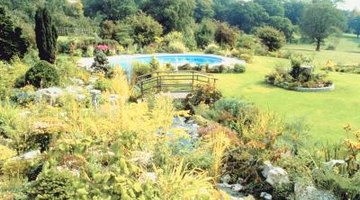How to Build a Simple Dam & Spillway for a Pond
Dams are usually the most attractive features of ponds. They add a sense of life to the tranquility of a body of water. They are very simple to make and often can be completed in one day. The hard part is making your dam long-lasting -- one that can stand the test of time. With the proper approach, you can use materials from around your pond to create an effective dam and beautiful spillway that will last season after season.

Step 1
Create a temporary dam upstream from where you would like to place the permanent dam. The permanent dam will create a transitional spillway flowing into your pond from its tributary. Align large rocks across the tributary (entry stream) about six feet upstream from the permanent dam. This will divert the water and create a shallow pool for you to work in while building the permanent dam.
Step 2
Dig a 2-foot-deep trench across the stream directly in front of where you will put the dam.
Step 3
Fill this trench with the largest rocks you are able to move (or smaller rocks depending on the depth of the stream). These rocks will serve as the foundation of the dam and support the rest of the material against the current of the stream.
Step 4
Make a layer of branches and leaves behind the large rocks. This layer should be as thick as the layer of large rocks. Stuff loose branches and leaves into the cracks between the large rocks. This is essential to effectively stop the flow of water from the stream.
Step 5
Make a layer of small-to-medium sized rocks behind the branches and leaves. Build this layer up and over the previous two layers. The current from the stream will push these smaller rocks against the branches to further seal the cracks between the large rocks.
Step 6
Remove the temporary dam slowly. Let the the pressure of the stream ease onto your permanent dam. The water level of the stream will rise behind the dam. When the water level rises higher than the dam, the water will flow over the top, creating a cascading spillway into your pond.
Photo Credits
- Jupiterimages/Photos.com/Getty Images
More Articles



